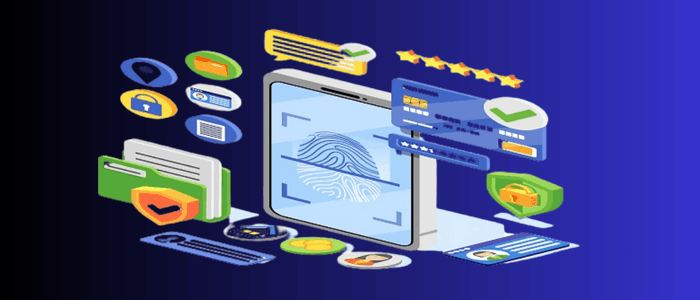In a world where even your toaster might be connected to the internet, protecting your digital identity has become as important as remembering your own name. Okay, maybe not that important, but it’s pretty darn close! Your digital identity is like your online alter ego, and it’s at risk from all sorts of online villains and digital ne’er-do-wells. So, let’s dive into the murky waters of online privacy and security, armed with a sense of humor and some practical tips.
Digital Identity and Its Importance
Picture this: you’re at a fancy party, dressed to the nines, and you’re the talk of the town. You’ve got a reputation to uphold. Well, guess what? Your digital identity is a bit like that reputation but on the internet. It’s the way you present yourself online, the trail of digital breadcrumbs you leave behind, and the online persona that’s uniquely you. And just like your reputation in the real world, your digital
identity can be tarnished or stolen.
Why should you care about it? Because your digital identity is connected to everything you do online. From social media profiles to online shopping accounts, it’s the key to your virtual kingdom. If it falls into the wrong hands, you could end up dealing with all sorts of digital disasters, from identity theft to cyberstalking.
Explanation of the Risks to Digital Identity in the Digital Age
In the good ol’ days (a.k.a. the pre-internet era), you didn’t have to worry about someone swiping your digital identity. But in today’s digital age, the risks are as real as that feeling of dread when you accidentally send a text to the wrong person.
Hackers, cybercriminals, and even nosy advertisers are constantly on the prowl for your digital identity. They want your personal information, your login credentials, and even your online behavior patterns. They’re like digital paparazzi, except instead of snapping unflattering photos, they’re after your data.
Understanding Online Privacy
Before we dive headfirst into the treacherous waters of online security, let’s talk about online privacy. Think of online privacy as your digital bubble bath. It’s that cozy, personal space where you can relax without worrying about prying eyes. But here’s the catch: unlike a real bubble bath, your online privacy isn’t automatically provided. You have to build it yourself. So, how do you maintain that cozy bubble of online privacy?
Steps for Protecting Digital Identity
Password Protection Imagine your password is like the secret handshake to your digital clubhouse. Make it strong and unique. Don’t use “123456” or “password” as your secret handshake. Use a combination of upper and lower-case letters, numbers, and symbols. And, for the love of memes, don’t use your pet’s name followed by your birth year!
Two-factor authentication (2FA)
Adding 2FA to your accounts is like having a bouncer at the door of your digital nightclub. Even if someone guesses your secret handshake (password), they’ll need a second form of identification to get in. It’s like the VIP pass for your digital life.
Regular Software Updates Updating your software is like getting regular check-ups at the doctor’s office. It may not be fun, but it keeps you healthy. Software updates often include security patches that fix vulnerabilities that hackers love to exploit.
Avoid Phishing Scams
Phishing scams are like the carnival games of the internet—deceptively enticing. Don’t click on suspicious links or download attachments from unknown sources. If an email promises you a million dollars in exchange for your bank details, it’s probably too good to be true.
Social Media and Digital Identity

Ah, social media—the place where you willingly share your life’s highlights with friends, family, and random strangers. It’s like inviting everyone over to check out your vacation photos and the occasional cat meme.
But remember, what goes online stays online. Your social media posts can reveal a lot about you, from your favorite vacation spot to your guilty pleasure for cat videos. Oversharing on social media can expose you to identity theft and cyberstalkers.
So, here are some golden rules:
1. Privacy Settings: Review and update your privacy settings regularly. Make sure you’re only sharing with people you trust. Your grandma doesn’t need to see those wild party pics, right?
2. Think Before You Post: Ask yourself, “Would I want my future boss, mother-in-law, or that random stranger from the internet to see this?” If the answer is “no,” maybe it’s not worth sharing.
3. Be Wary of Friend Requests: Just because someone sends you a friend request doesn’t mean they’re your new BFF. Verify their identity before accepting.
Cybersecurity and Digital Identity
Now, let’s talk about the love story between cybersecurity and digital identity. They’re like the Bonnie and Clyde of the digital world, except one’s a hero and the other’s a villain.
Overview of the Connection Between Cybersecurity and Digital Identity
Your digital identity is like a dam, and cybersecurity is the team of engineers and guards tasked with keeping it secure. Cybersecurity is all about safeguarding your digital information from bad actors lurking in cyberspace.
Explanation of the Types of Cybersecurity Threats That Can Affect Digital Identity
Cybersecurity threats are like the boogeymen of the internet—scary, but you can protect yourself from them. Here are a few of the nastiest ones:
1. Malware: Malicious software that can infect your device and steal your data. It’s like a sneaky spy that infiltrates your digital life.
2. Phishing: We’ve already mentioned this one, but it’s worth repeating. Phishing is when scammers try to trick you into revealing personal information through fake emails or websites. Don’t take the bait!
3. Ransomware: Imagine a digital kidnapper who locks your files and demands a ransom to release them. That’s ransomware for you.
4. Data Breaches: When companies get hacked, your personal information can be exposed. That’s why it’s crucial to use different passwords for different accounts. You don’t want one breach to unlock the entire digital treasure chest of your life.
Steps for Protecting Digital Identity from Cybersecurity Threats
Think of these steps as the superhero toolkit for your digital identity:
1. Invest in Antivirus Software: Antivirus software is like your personal security guard against malware. Get a reputable one and keep it up to date.
2. Keep Your Operating System Updated: Remember those software updates? They’re even more critical for your operating system. They often patch vulnerabilities that cybercriminals love to exploit.
3. Use a Virtual Private Network (VPN): A VPN is like your digital invisibility cloak. It encrypts your internet connection and masks your IP address, making it harder for anyone to snoop on you.
4. Educate Yourself: Knowledge is power. Stay informed about the latest cybersecurity threats and best practices. Don’t be the digital damsel in distress—be the savvy superhero.
Online Shopping and Digital Identity
Online shopping is like a magical kingdom where you can buy anything without leaving your couch. But it’s also a playground for cybercriminals. When shopping online, remember:
Use Trusted Websites: Stick to reputable online stores. If a website looks like it was designed by your cousin Vinny in the ’90s, steer clear.
Check for HTTPS: Before entering your credit card info, make sure the website’s URL starts with “https://” and has a little padlock icon in the address bar. It’s like the digital version of checking for a store’s security guard.
Mobile App Security
We live in the age of apps. There’s an app for everything, from ordering pizza to tracking your daily steps. But apps can be a backdoor to your digital identity:
Only Download From Official Stores: Stick to downloading apps from official app stores like Apple’s App Store or Google Play. Third-party apps are like back-alley deals – risky business.
Review App Permissions: Apps often ask for access to your camera, contacts, and other personal info. Before granting permission, ask yourself if the app really needs it. Does that flashlight app need access to your location? Probably not.
Password Managers: Your Digital BFFs
Managing passwords can feel like herding cats. That’s where password managers come to the rescue:
- They create and store strong, unique passwords for each of your accounts. Your memory will thank you.
- Some even offer a feature that alerts you if any of your accounts have been breached.
Digital Spring Cleaning
Just like your grandma’s attic, your digital life can accumulate a lot of junk over time. It’s time for some digital spring cleaning:
Delete Old Accounts: If you have accounts on websites you haven’t visited since the dawn of the internet, consider deleting them. Fewer accounts mean fewer potential vulnerabilities.
Clear Out Unused Apps: If you’re not using an app, why let it hang around? Delete those digital dust collectors.
The Dark Side of Public Wi-Fi
Public Wi-Fi is like a siren’s song for travelers and coffee shop aficionados. But it can be a treacherous sea for your digital identity:
Avoid Logging into Sensitive Accounts: Don’t do your online banking or access sensitive information on public Wi-Fi. It’s like broadcasting your personal data to the world.
Use a VPN (Again!): If you must use public Wi-Fi, employ a VPN. It’s like putting a force field around your data.
Monitoring Your Digital Footprint
Ever wondered how big your digital footprint is? It’s time to find out:
Google Yourself: Yep, you read that right. Search for your name online and see what information comes up. If you find something you don’t like, contact the website to have it removed.
Use Online Reputation Management Tools: Some tools can help you track and manage your online presence. It’s like having a PR agent for your digital life.
Educate Your Inner Circle
Your digital identity isn’t just about you; it also involves the people you connect with. So, it’s essential to educate your friends and family:
- Teach them about online privacy and security best practices.
- Encourage them to be mindful of the information they share online, especially when it comes to tagging you in posts or photos.
The Human Element: Social Engineering
Sometimes, the most significant threat isn’t a high-tech hacker but a clever con artist. Social engineering attacks rely on manipulating people rather than hacking systems:
- Be cautious when receiving unsolicited calls or emails asking for personal information. Scammers can pose as tech support, your bank, or even a long-lost relative.
- Verify the identity of anyone requesting sensitive information, especially if they claim to be from an official organization.
Backup Your Data
Imagine your digital identity as a beautiful sandcastle on the digital beach. Backing up your data is like taking a snapshot of that sandcastle, so if a rogue digital wave crashes over it, you can rebuild:
- Regularly back up important files and data. You can use cloud storage or external hard drives.
- Test your backups to ensure they’re functional.
Keep Your Devices Secure
Your devices are like the gates to your digital kingdom. Here’s how to fortify them:
- Use strong, unique passcodes or biometric authentication (fingerprint, face recognition) to lock your devices.
- Install security apps or features to remotely track, lock, or wipe your device in case it’s lost or stolen.
Conclusion: Embracing Digital Defender Status
In this age of cat videos, memes, and endless shopping carts, safeguarding your digital identity is crucial. Armed with strong passwords, trusty VPNs, and regular digital spring cleaning, you’re equipped to face the online wilderness.
But amidst all the fun, keep a watchful eye. While the digital world is amusing, it pays to be cautious. Your digital identity is precious, and protecting it can be as entertaining as it is essential.
So, march forward as a netizen of wisdom and humor. Your digital identity is your crown, and you rule your online kingdom. Go forth and meme responsibly!

